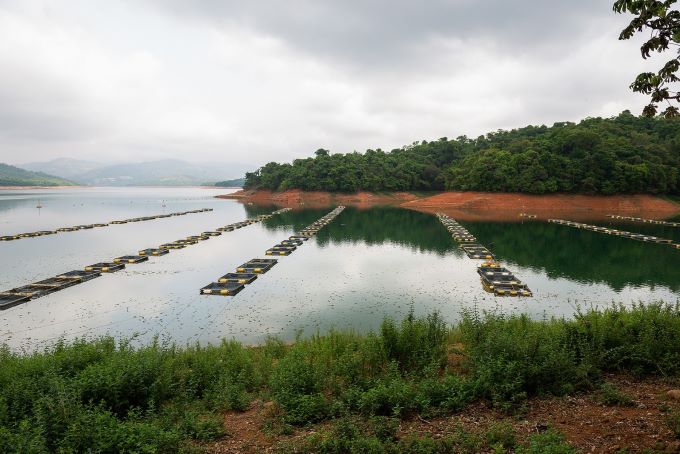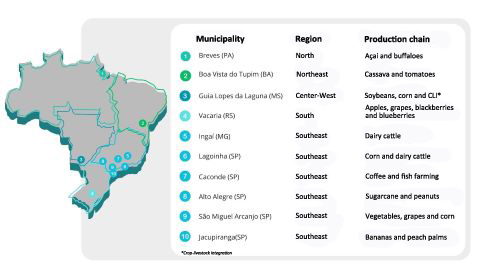


Coffee growing and fish farming in Caconde, São Paulo state (photo: Lilian Alves/EMBRAPA Agricultura Digital)
Published on 12/04/2023
Agência FAPESP – The Science for Development Center in Digital Agriculture (CCD-AD/SemeAr Digital), funded by FAPESP and run by EMBRAPA Digital Agriculture, a decentralized unit of the Brazilian Agricultural Research Corporation (EMBRAPA), embarked in November on a program of digital inclusion in ten municipalities scattered across Brazil’s five regions. The initiative has the potential to reach up to 14,000 small and medium rural properties.
Research, development and innovation activities relating to emerging technologies will be conducted in production environments called Agricultural Technological Districts (DATs, short for Distritos Agrotecnológicos). Pilot projects have been in progress for two years at Caconde and São Miguel Arcanjo in São Paulo state. Three more will be established in the same state, at Jacupiranga, Lagoinha and Alto Alegre, as well as another at Ingaí in Minas Gerais state, also in the Southeast region.
The other regions will be integrated into the project via Breves in Pará state (North), Boa Vista do Tupim in Bahia state (Northeast), Guia Lopes da Laguna in Mato Grosso do Sul state (Center-West) and Vacaria in Rio Grande do Sul state (South).
Each DAT will be subject to socio-economic diagnosis to identify focal points and to benchmark rural properties (see below for the production chains involved in each municipality).
“It’s pointless to construct a digital inclusion project without engaging with farmers and listening to their demands,” said EMBRAPA CEO Silvia Massruhá, who created the initiative and is the principal investigator for the center. “SemeAr Digital will work with farmers’ associations and co-ops on an interdisciplinary basis, fostering collaboration with partner institutions in research and innovation, connectivity and training,” she said (semear is Portuguese for seeding).
The aims of the project are to promote digital agriculture along inclusive lines so as to reduce market asymmetries, improve the well-being of the communities involved, and contribute to sustainable development of the respective production chains, Massruhá explained.
“The center will offer small and medium farmers connectivity and digital technology to help them increase their income and call in technical services via the internet,” said Marcio de Castro, FAPESP’s Scientific Director.
The center will propose solutions suited to local conditions and will research, develop and validate technologies that enable them. It will build partnerships to improve connectivity and communications. It will also provide training for agricultural technicians, digital technology consultants and farmers through trade associations, co-ops, and public or private rural extension offices.
Potential partners, depending on the stage of each DAT, will include farmers or their co-ops and major suppliers, startups and programs that support entrepreneurship and open innovation, financial agents in the federal, state and municipal spheres, as well as higher education and research institutions.
Collaborative research
The need to foster a dialogue among institutions and disciplines, create methodologies involving similar approaches to different areas and cultures, and surmount a lack of familiarity with digital agriculture are some of the challenges faced by the scientists, who aim to deploy novel tools for digital inclusion of small and medium farmers, according to Durval Dourado Neto, the center’s chief scientist.
Dourado Neto is a professor and coordinator of the Public Policy Group at the University of São Paulo’s Luiz de Queiroz College of Agriculture (ESALQ-USP), one of the center’s partners, alongside the Campinas Institute of Agronomy (IAC) and the Agricultural Economics Institute (IEA), arms of São Paulo’s Agency for Agribusiness Technology (APTA); the Federal University of Lavras (UFLA); and the National Institute of Telecommunications (INATEL) and the Center for Research and Development in Telecommunications (CPQD), private-sector higher education and research institutions.

Professor Durval (in yellow shirt) and teams visiting a producer of coffee and tilapia in Caconde (photo Valéria Costa)
Dourado Neto stressed the importance of the hands-on agricultural R&D capabilities assured by all these partnerships. “Contact with the production environment is extremely important to help identify the best way to advance scientific knowledge and develop solutions to the needs of producers in every one of the DATs,” he said.
Initially, eight of EMBRAPA’s units will be involved so as to encompass all regions and relevant knowledge areas: EMBRAPA Eastern Amazonia, EMBRAPA Grape and Wine, EMBRAPA Agriculture West, EMBRAPA Cassava and Fruit, EMBRAPA Cerrados, EMBRAPA Environment, EMBRAPA Livestock Southeast, and EMBRAPA Instrumentation.
Locations and production chains

Source: EMBRAPA
Municipalities were selected for DATs in accordance with technical criteria such as socio-economic indicators, population density, education, infrastructure, internet use and computer literacy, Dourado Neto explained. The median score for new technology adoption was also important because these locations will benefit most from the infrastructure to be installed there as part of the DATs. The final choice was based above all on logistics, technical support, and diversity of biomes and agricultural activities.
The survey used statistics from public institutions with recognized technical capabilities, such as IBGE, the national census bureau, which supplied the findings of the latest agricultural census, conducted in 2017.
The researchers considered 34 indicators applicable to municipalities in all five regions of Brazil, ensuring that the choice would be aligned with the aims of the center, according to IEA Technical Director Priscilla Fagundes, who designed the methodology. “Studies conducted in pilot municipalities gleaned useful information for application in the other DATs, including a vision of different scenarios to facilitate expansion under the aegis of the center,” she said.
Pilot projects point to priorities
The production chains selected on the basis of the pilot projects’ results were coffee in Caconde, and fruit and vegetables in São Miguel Arcanjo. The rural communities concerned were at different stages of connectivity when the projects arrived. Caconde had internet access, whereas São Miguel Arcanjo did not, for example. Their main demand was the capacity to add value.
As recalled by Luciana Romani, the center’s coordinator of partnerships and a researcher at EMBRAPA Digital Agriculture, connectivity was provided for 63 producers of grapes and other fruit and vegetable produce in São Miguel Arcanjo, where the pilot project is run by CPQD. A survey of the farmers involved showed average income growth of 28% and average cost savings of 24%. About 60% said product quality improved. In September, the project won a prize for the best private network in agriculture awarded by ANATEL, the National Telecommunications Agency, and ABDI, the Brazilian Industrial Development Agency.
For Ademar Pereira, who heads the farmers’ association in Caconde, the positive effects of the project are already visible, including the attraction of public and private investment in agriculture there. “We need sensitive technicians and depend on public policy. They’re arriving now, thanks to SemeAr Digital. We now have connectivity in Caconde, with 73 antennas and 1,350 internet subscribers. Being organized has done us good,” he said.
Next steps
After the other municipalities are brought in, a socio-economic survey and analysis of the main agricultural activities will be conducted in each locality in order to align the needs of production chains there with the producers’ digital requirements and the technological solutions offered. The surveys will also show which properties can serve as benchmarks in each DAT.
The initial identification of needs and demands is a key step to ensure positive results, according to Dourado Neto. “Local institutional relationships must also be built so that the results of the survey can validate strategies and technological solutions with a positive impact in each locality,” he said.
Source: https://agencia.fapesp.br/50387